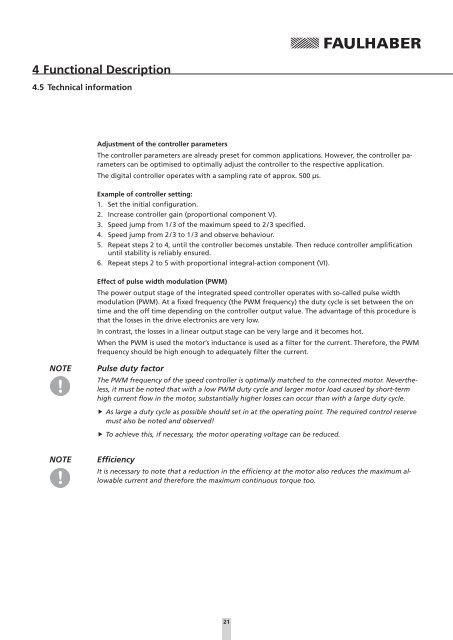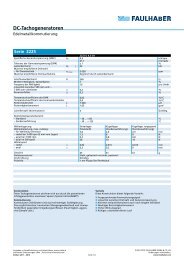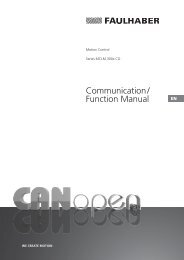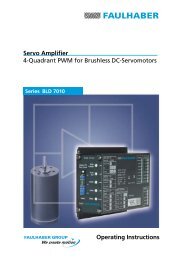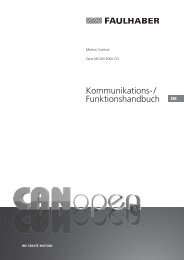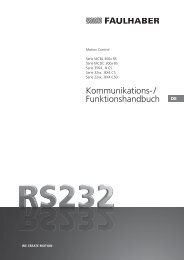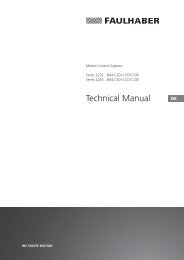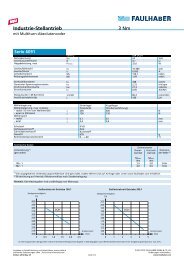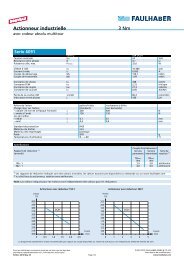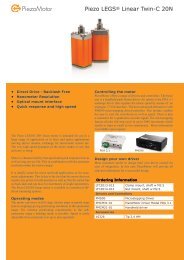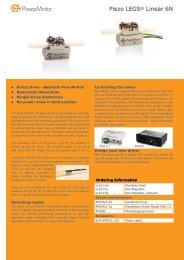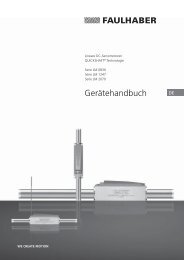Instruction Manual - Dr. Fritz Faulhaber GmbH & Co. KG
Instruction Manual - Dr. Fritz Faulhaber GmbH & Co. KG
Instruction Manual - Dr. Fritz Faulhaber GmbH & Co. KG
Create successful ePaper yourself
Turn your PDF publications into a flip-book with our unique Google optimized e-Paper software.
4 Functional Description<br />
4.5 Technical information<br />
Adjustment of the controller parameters<br />
The controller parameters are already preset for common applications. However, the controller parameters<br />
can be optimised to optimally adjust the controller to the respective application.<br />
The digital controller operates with a sampling rate of approx. 500 µs.<br />
Example of controller setting:<br />
1. Set the initial configuration.<br />
2. Increase controller gain (proportional component V).<br />
3. Speed jump from 1 / 3 of the maximum speed to 2 / 3 specified.<br />
4. Speed jump from 2 / 3 to 1 / 3 and observe behaviour.<br />
5. Repeat steps 2 to 4, until the controller becomes unstable. Then reduce controller amplification<br />
until stability is reliably ensured.<br />
6. Repeat steps 2 to 5 with proportional integral-action component (VI).<br />
Effect of pulse width modulation (PWM)<br />
The power output stage of the integrated speed controller operates with so-called pulse width<br />
modulation (PWM). At a fixed frequency (the PWM frequency) the duty cycle is set between the on<br />
time and the off time depending on the controller output value. The advantage of this procedure is<br />
that the losses in the drive electronics are very low.<br />
In contrast, the losses in a linear output stage can be very large and it becomes hot.<br />
When the PWM is used the motor’s inductance is used as a filter for the current. Therefore, the PWM<br />
frequency should be high enough to adequately filter the current.<br />
NOTE<br />
Pulse duty factor<br />
The PWM frequency of the speed controller is optimally matched to the connected motor. Nevertheless,<br />
it must be noted that with a low PWM duty cycle and larger motor load caused by short-term<br />
high current flow in the motor, substantially higher losses can occur than with a large duty cycle.<br />
ffAs large a duty cycle as possible should set in at the operating point. The required control reserve<br />
must also be noted and observed!<br />
ffTo achieve this, if necessary, the motor operating voltage can be reduced.<br />
NOTE<br />
Efficiency<br />
It is necessary to note that a reduction in the efficiency at the motor also reduces the maximum allowable<br />
current and therefore the maximum continuous torque too.<br />
21


